During the pandemic, the leisure and hospitality industry was arguably the hardest hit to earnings as lockdowns shuttered businesses across the country. Of course, restaurants saw significant problems during the pandemic, but investors quickly dove back into the industry as recovery appeared on the horizon.
Restaurant Industry Trends
In fact, as earnings season continues for U.S. restaurants, the industry is now trading at a price-to-earnings (P/E) ratio of 51.1. Although that’s significantly lower than where it was trading at the week ended Aug. 4 (67.6), it’s still significantly higher than the industry’s three-year average P/E of 44.2. Meanwhile, the restaurant industry is trading around its three-year average price-to-sales (P/S) ratio of 2.2.
We’re now past the halfway mark in 2023, so we’re getting a pretty good picture of how things are going for the restaurant industry. Restaurant profit margins tend to be slim versus those in other industries, which means rising costs can quickly become critical issues in some chains. However, that’s not the problem we’re seeing in the second-quarter earnings reports.
On one hand, food and labor costs have been rising this year. According to the National Restaurant Association’s 2023 State of the Restaurant Industry report, half of restaurant operators expect lower profits this year compared to last year. However, revenues are where most chains are coming up short versus expectations.
Many restaurant chains have released their second-quarter earnings reports, and generally, we’re seeing some attractive trends. However, while the U.S. Bureau of Labor Statistics reports an 8% increase in menu prices, many chains have disappointed with their sales numbers. As a result, investors have been taking out their frustrations on the companies’ stock prices.
Fast-Casual Chain Earnings
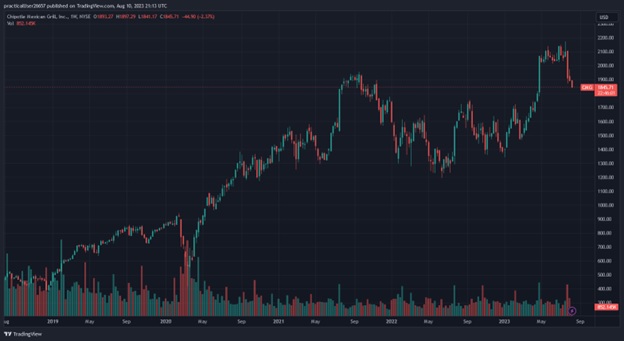
Chipotle Mexican Grill, a long-time Wall Street darling, smashed the consensus for earnings, coming in at $12.65 on an adjusted basis, although it reported in-line sales of $2.5 billion. While the fast-casual chain’s same-store sales rose an attractive 7.4%, they came up slightly short of the StreetAccount consensus of 7.5%.
However, Chipotle’s long-term earnings trends look quite solid with steady growth, not only in sales but also in profits. In fact, the company’s net income margins reached 12% for the last 12 months — much better than most restaurant chains. However, shares of Chipotle have plunged 12% over the last month.
While Chipotle has been public since January 2006, CAVA Group is at the other end of the spectrum, having just gone public in June. Many have declared it to be the next Chipotle. However, CAVA is not only unprofitable it has also been seeing widening losses. Despite that, it’s trading at an incredibly high P/S of 9, compared to Chipotle’s P/S of 5.5. The company’s stock was down by 2% midday on Tuesday prior to its earnings report’s release.
Shake Shack posted adjusted earnings of 18 cents per share on $271.8 million in sales, compared to the consensus numbers of 10 cents per share and $274.5 million in revenue. Its stock price initially surged despite the sales miss, although it has since fallen nearly back to where it was pre-earnings.
Fast-Food Operators
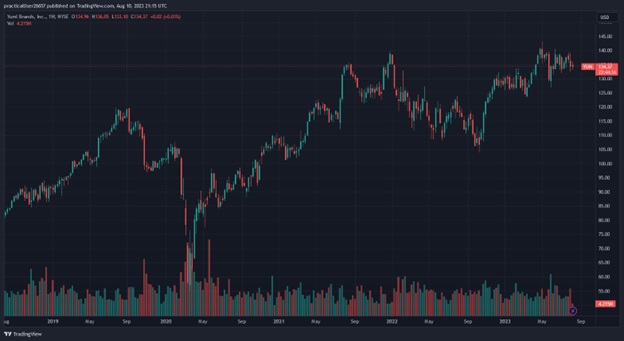
Yum! Brands beat the second-quarter consensus for profits but missed slightly on revenue, coming in at $1.41 per share as adjusted on $1.7 billion in sales. In fact, Yum enjoys an attractive net profit margin of 25%, also putting it ahead of much of the rest of the industry. The fast-food-chain operator reported same-store sales growth of 9%, also very healthy, although its stock has tumbled following the revenue disappointment.
Fast-food bellwether McDonald’s managed to beat estimates for both earnings and revenue, coming in at $3.17 per share on $6.5 billion in sales for the second quarter. However, even McDonald’s hasn’t been able to inspire investors, as its shares have continued to slip since the July 27 earnings release.
Restaurant Brands International reported adjusted earnings of $1.14 per share on $1.78 billion in revenue, beating the consensus numbers of 77 cents per share on $1.75 billion in sales. The stock has ticked slightly higher since the earnings release on August 8.
Sit-Down Dining Earnings
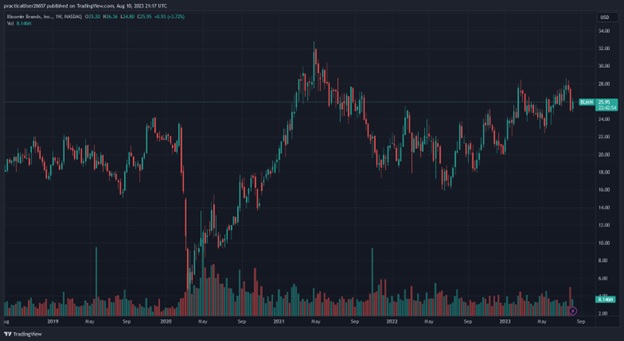
Bloomin’ Brands beat on earnings and reported in-line revenue, with adjusted earnings of 70 cents per share on $1.15 billion in sales. The stock initially ticked slightly lower before reversing into a small rally. Interestingly, Bloomin’ is trading at a P/S of only 0.5, a steep discount to the industry.
Darden Restaurants last reported in June, posting $2.60 per share in adjusted earnings on $2.77 billion in revenue, versus the consensus numbers of $2.53 per share on $2.77 billion in sales. Shares of Darden have held up pretty well since that earnings release.
Coffee Shops
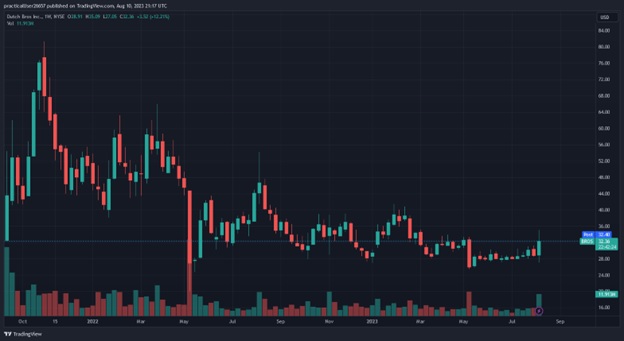
Dutch Bros. bucked the industry trend of stock-price declines after sales misses, surging more than 10% over the last five days. The coffee-shop chain reported earnings of 13 cents per share on $249.9 million in revenue, versus the consensus numbers of 6 cents per share on $253.1 million in sales.
Although Dutch Bros. is trading at a P/S of 2.3, in line with the restaurant industry, its P/E is, at the time of this writing, an astonishing 60,000% (not a typo!). Essentially, investors seem overly thrilled by the shift to profitability over the last 12 months.
Starbucks reported $1 per share in adjusted earnings on $9.2 billion in sales, compared to the consensus numbers of 95 cents per share on $9.3 billion in revenue. Like most other chains, Starbucks shares pulled back after the revenue miss, although they have since bounced back.
Top restaurant ETFs
Generally, most restaurant chains smashed earnings estimates but slightly missed on sales, likely because customers bought fewer items because of the 8% increase in menu prices. However, these results show that for the most part, the restaurant industry has recovered from the pandemic.
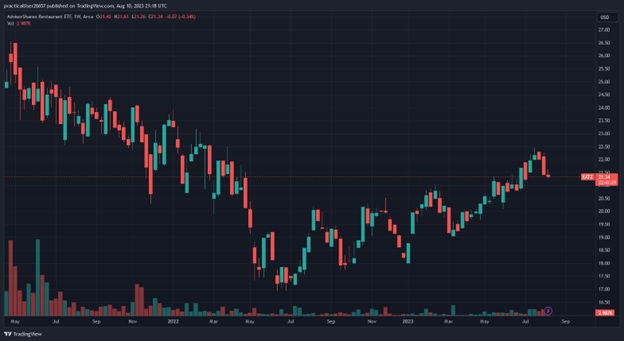
There appears to be only one exchange-traded fund that invests exclusively in restaurants and food service companies, which is the AdvisorShares Restaurant ETF (EATZ). Year to date, the ETF is up 18%, so it’s holding up pretty well despite the post-earnings selloffs we’ve been seeing throughout the sector.
As of August 10, the ETF’s top holdings included Arcos Dorados, Bloomin’ Brands, Restaurant Brands International, Carrols Restaurant Group, and BJ’s Restaurants.
The Invesco Dynamic Leisure and Entertainment ETF (PEJ) also offers decent exposure to restaurants. Among its top 10 holdings are Yum! China and Chipotle Mexican Grill. PEJ is up 16% year to date.
All charts via TradingView.
For more news, information, and analysis, visit the Equity ETF Channel.


